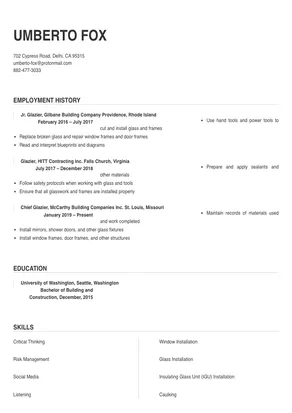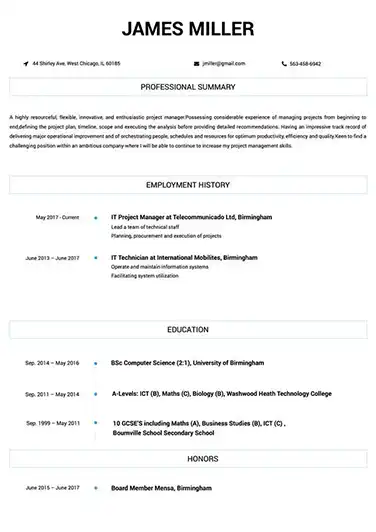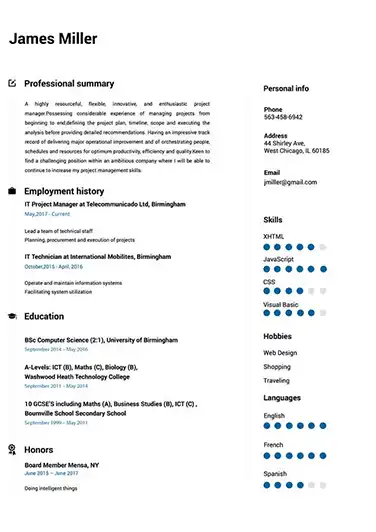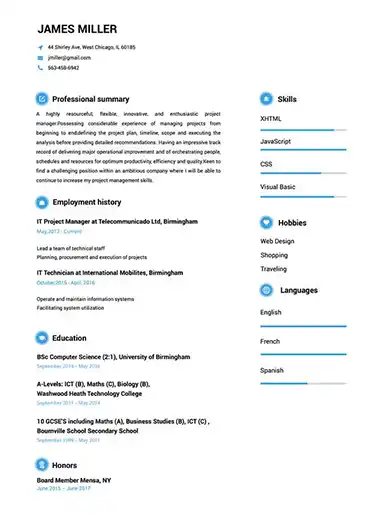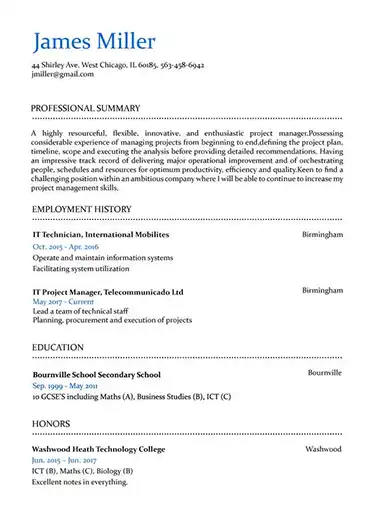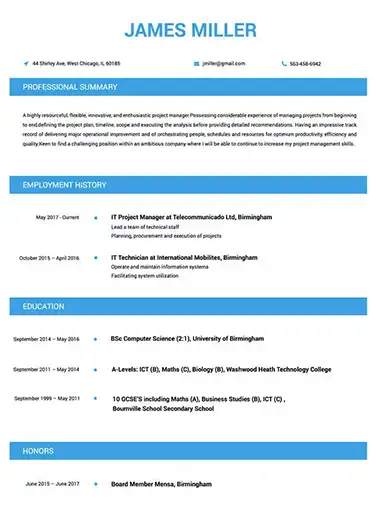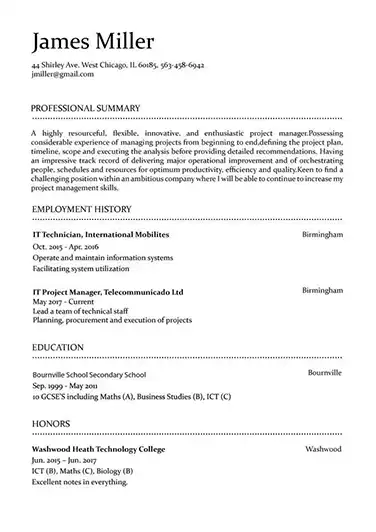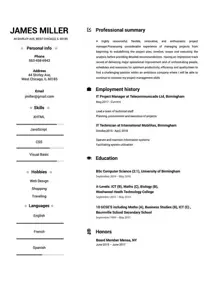 Use This Template
Use This Template
Build your resume in 15 minutes
Create an awesome resume that meets the expectations of potential employers with our selection of professional, field-tested resume templates.
glazier: Resume Samples & Writing Guide
umberto-fox@protonmail.com
882-477-3033
Employment history
- Maintain records of materials used and work completed
- Install mirrors, shower doors, and other glass fixtures
- Install window frames, door frames, and other structures
- Prepare and apply sealants and other materials
- Follow safety protocols when working with glass and tools
- Ensure that all glasswork and frames are installed properly
- Use hand tools and power tools to cut and install glass and frames
- Replace broken glass and repair window frames and door frames
- Read and interpret blueprints and diagrams
Education
Skills
Do you already have a resume? Use our PDF converter and edit your resume.
quinnfrancis17@inbox.com
619-404-2233
Professional Summary
Employment history
- Install window frames, door frames, and other structures
- Prepare and apply sealants and other materials
- Ensure that all glasswork and frames are installed properly
- Maintain records of materials used and work completed
- Install mirrors, shower doors, and other glass fixtures
- Use hand tools and power tools to cut and install glass and frames
- Prepare and apply sealants and other materials
- Measure and mark glass for cutting and installation
- Work with customers to determine their glass and frame needs
Education
Skills
turnervic@aol.com
639-670-6839
Employment history
- Use hand tools and power tools to cut and install glass and frames
- Install mirrors, shower doors, and other glass fixtures
- Measure and mark glass for cutting and installation
- Use hand tools and power tools to cut and install glass and frames
- Read and interpret blueprints and diagrams
- Inspect and maintain existing glasswork and frames
- Use hand tools and power tools to cut and install glass and frames
- Prepare and apply sealants and other materials
- Cut and install glass in windows, skylights, and other structures
Education
Skills
oscar.quinn@inbox.com
971-850-3694
Employment history
- Maintain records of materials used and work completed
- Replace broken glass and repair window frames and door frames
- Inspect and maintain existing glasswork and frames
- Install mirrors, shower doors, and other glass fixtures
- Follow safety protocols when working with glass and tools
- Cut and install glass in windows, skylights, and other structures
- Clean up work areas and remove debris
- Install window frames, door frames, and other structures
- Replace broken glass and repair window frames and door frames
Education
Skills
neilscott36@mail.com
706-710-4856
Employment history
- Inspect and maintain existing glasswork and frames
- Prepare and apply sealants and other materials
- Clean up work areas and remove debris
- Inspect and maintain existing glasswork and frames
- Cut and install glass in windows, skylights, and other structures
- Ensure that all glasswork and frames are installed properly
- Follow safety protocols when working with glass and tools
- Use hand tools and power tools to cut and install glass and frames
- Clean up work areas and remove debris
Education
Skills
Not in love with this template? Browse our full library of resume templates
glazier Job Descriptions; Explained
If you're applying for an glazier position, it's important to tailor your resume to the specific job requirements in order to differentiate yourself from other candidates. Including accurate and relevant information that directly aligns with the job description can greatly increase your chances of securing an interview with potential employers.
When crafting your resume, be sure to use action verbs and a clear, concise format to highlight your relevant skills and experience. Remember, the job description is your first opportunity to make an impression on recruiters, so pay close attention to the details and make sure you're presenting yourself in the best possible light.
glazier
- Fasten glass panes into wood sashes or frames with clips, points, or moldings, adding weather seals or putty around pane edges to seal joints.
- Secure mirrors in position, using mastic cement, putty, bolts, or screws.
- Cut and attach mounting strips, metal or wood moldings, rubber gaskets, or metal clips to surfaces in preparation for mirror installation.
- Fabricate or install metal sashes or moldings for glass installation, using aluminum or steel framing.
glazier
- Determine plumb of walls or ceilings, using plumb lines and levels.
- Measure mirrors and dimensions of areas to be covered to determine work procedures.
- Cut, fit, install, repair, or replace glass or glass substitutes, such as plastic or aluminum, in building interiors or exteriors or in furniture or other products.
- Cut and remove broken glass prior to installing replacement glass.
- Operate cranes or hoists with suction cups to lift large, heavy pieces of glass.
- Set glass doors into frames and bolt metal hinges, handles, locks, or other hardware to attach doors to frames and walls.
- Select the type or color of glass or mirror according to specifications.
glazier
- Cut, assemble, fit, or attach metal-framed glass enclosures for showers, bathtubs, display cases, skylights, solariums, or other structures.
- Drive trucks to installation sites and unload mirrors, glass equipment, or tools.
- Install pre-assembled metal or wood frameworks for windows or doors to be fitted with glass panels, using hand tools.
- Assemble, erect, or dismantle scaffolds, rigging, or hoisting equipment.
glazier
- Shipment receiving/ loading
- Gather material for task at hand
- Install certain material per details
- Glaze window systems
- Water proofing windows
glazier/helper
- Responsible for the measure, delivery, installation, and maintenance of framed, semi-frameless, and frameless shower enclosures.
- Measure, cut, seam/polish, and install mirrors, including specialty pattern cuts, as well as framed or inset installation.
- Operate lifts safely to install glass.
- Measure and install curtain wall, closers, storefronts, or any other commercial units.
glazier Job Skills
For an glazier position, your job skills are a key factor in demonstrating your value to the company and showing recruiters that you're the ight fit for the role. It's important to be specific when highlighting your skills and ensure that they are directly aligned with the job requirements, as this can greatly improve your chances of being hired. By showcasing your relevant skills and experience, you can make a compelling case for why you're the best candidate for the job.
How to include technical skills in your resume:
Technical skills are a set of specialized abilities and knowledge required to perform a particular job
effectively. Some examples of technical skills are data analysis, project management, software proficiency,
and programming languages, to name a few.
Add the technical skills that will get hired in your career
field with our simple-to-use resume builder. Select your desired resume template, once you reach the skills
section of the builder, manually write in the skill or simply click on "Add more skills". This will
automatically generate the best skills for your career field, choose your skill level, and hit "Save &
Next."
- Glazing
- Glass Cutting
- Glass Installation
- Window Installation
- Window Repair
- Measurement and Estimation
- Aluminium Fabrication
- Heat Treatment
- Site Safety
- Tool Maintenance
- Caulking
- Insulating Glass Unit (IGU) Installation
- Glass Lifting
- Glazing Techniques
- Reading Blueprints
- Vinyl Wrapping
- Construction Regulations
- Ladder Work
- Protective Gear
- Hazardous Materials
- Soldering.
How to include soft skills in your resume:
Soft skills are non-technical skills that relate to how you work and that can be used in any job. Including
soft skills such as time management, creative thinking, teamwork, and conflict resolution demonstrate your
problem-solving abilities and show that you navigate challenges and changes in the workplace
efficiently.
Add competitive soft skills to make your resume stand-out to recruiters! Simply select
your preferred resume template in the skills section, enter the skills manually or use the "Add more skills"
option. Our resume builder will generate the most relevant soft skills for your career path. Choose your
proficiency level for each skill, and then click "Save & Next" to proceed to the next section.
- Communication
- Interpersonal
- Leadership
- Time Management
- Problem Solving
- Decision Making
- Critical Thinking
- Creativity
- Adaptability
- Teamwork
- Organization
- Planning
- Public Speaking
- Negotiation
- Conflict Resolution
- Research
- Analytical
- Attention to Detail
- Self-Motivation
- Stress Management
- Collaboration
- Coaching
- Mentoring
- Listening
- Networking
- Strategic Thinking
- Negotiation
- Emotional Intelligence
- Adaptability
- Flexibility
- Reliability
- Professionalism
- Computer Literacy
- Technical
- Data Analysis
- Project Management
- Customer Service
- Presentation
- Written Communication
- Social Media
- Troubleshooting
- Quality Assurance
- Collaboration
- Supervisory
- Risk Management
- Database Management
- Training
- Innovation
- Documentation
- Accounting
- Financial Management
- Visualization
- Reporting
- Business Acumen
- Process Improvement
- Documentation
- Relationship Management.
How to Improve Your glazier Resume
Navigating resume pitfalls can mean the difference between landing an interview or not. Missing job descriptions or unexplained work history gaps can cause recruiters to hesitate. Let's not even talk about the impact of bad grammar, and forgetting your contact info could leave your potential employer hanging. Aim to be comprehensive, concise, and accurate.
Employment history
- Install mirrors, shower doors, and other glass fixtures
- Follow safety protocols when working with glass and tools
- Cut and install glass in windows, skylights, and other structures
- Work with customers to determine their glass and frame needs
- Replace broken glass and repair window frames and door frames
- Install mirrors, shower doors, and other glass fixtures
- Clean up work areas and remove debris
- Work with customers to determine their glass and frame needs
- Follow safety protocols when working with glass and tools
Education
Skills
Provide your Contact Information and Address Year Gaps
Always explain any gaps in your work history to your advantage.
Key Insights- Employers want to know what you've accomplished, so make sure to explain any gaps using a professional summary.
- Adding extra details and context to explain why you have a gap in your work history shows employers you are a good fit for the position.
How to Optimize Your glazier Resume
Keep an eye out for these resume traps. Neglecting to detail your job roles or explain gaps in your career can lead to unnecessary doubts. Grammar blunders can reflect negatively on you, and without contact information, how can employers reach you? Be meticulous and complete.
turnergeorge80@gmail.com
903-793-3723
Employment history
- Instal mirror's, shower door's, and other glass fixture's.
- Prepear and aply sealents and othar materiels.
- Folow safty protocolls when working wit glasss and toolss.
- Uses hand tools and power tools to cuts and installs glass and frames.
- Installe mirrors, shower doos, and other glass fixtuers.
- Assemble, intall, an' repair glass an' metal frames.
Education
Skills
Include Job Descriptions and Avoid Bad Grammar
Avoid sending a wrong first impression by proofreading your resume.
Key Insights- Spelling and typos are the most common mistakes recruiters see in resumes and by simply avoiding them you can move ahead on the hiring process.
- Before submitting your resume, double check to avoid typos.
glazier Cover Letter Example
A cover letter can be a valuable addition to your job application when applying for an glazier position. Cover letters provide a concise summary of your qualifications, skills, and experience, also it also gives you an opportunity to explain why you're the best fit for the job. Crafting a cover letter that showcases your relevant experience and enthusiasm for the Accounts Payable role can significantly improve your chances of securing an interview.
Fox umberto-fox@protonmail.com
882-477-3033
702 Cypress Road, Delhi, CA
95315
Whiting-Turner Contracting Company
Baltimore, Maryland
Esteemed Whiting-Turner Contracting Company Hiring Team
I am a highly motivated Glazier with 7 years of experience in Building & Construction. I am excited to submit my application for the Chief Glazier position at Whiting-Turner Contracting Company, where I believe my skills and expertise would be an excellent fit.
As someone who has faced challenges in various areas of my life and has overcome them, I am confident in my ability to adapt and thrive in any environment. I have developed a reputation for being a collaborative team player and an effective problem solver, which has been instrumental in my career's success. With my experience and passion for Building & Construction, I am excited to apply my skills to this role and contribute to your organization's growth and success.
I appreciate the opportunity to apply for the Chief Glazier position. I am confident that I can make a valuable contribution to your organization and that together there is no challenge that we cannot overcome. I will be waiting, hopeful for what the future will bring.
Looking forward to hearing from you,
Umberto Fox
882-477-3033
umberto-fox@protonmail.com
Umberto Fox
Showcase your most significant accomplishments and qualifications with this cover
letter.
Personalize this cover letter in just few minutes with our user-friendly tool!
Related Resumes & Cover Letters

Build your Resume in 15 minutes
Create an awesome resume that meets the expectations of potential employers with our selection of professional, field-tested resume templates.
